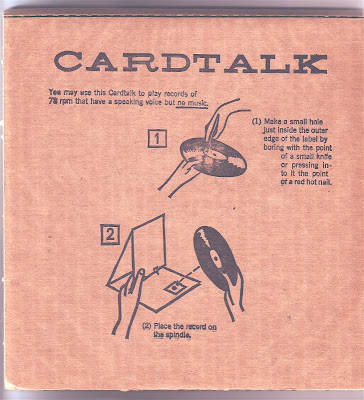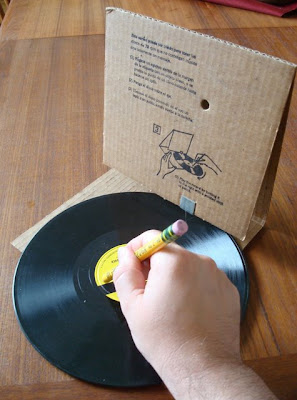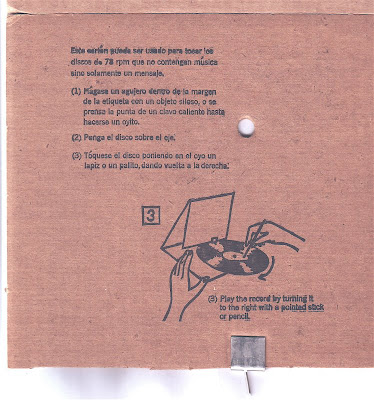You may use this Cardtalk to play records of 78 rpm that have a speaking voice but no music
 "The 'Cardtalk' is essentially a folded piece of cardboard with a nail attached." is what our friends over at Learning To Share blog says, who recently unearthed this device.
"The 'Cardtalk' is essentially a folded piece of cardboard with a nail attached." is what our friends over at Learning To Share blog says, who recently unearthed this device.The CardTalk phonograph record player is the classic definition of a paradox. While very few collectors know what a CardTalk is, and even fewer own one, approximately a million have been made and distributed world wide. Although it is truly a phonograph record playing machine, it has no moving parts, costs less than a dollar to manufacture, and has remarkably good sound fidelity. And finally, it coexists, without fear, with the most complex of sound reproduction machines in this world of complex electronic marvels.
 This amazing little phonograph was developed in the late 1940s by The World Literature Crusade, a religious organization, to help it fulfill its mission of spreading Christian bible ministry throughout the world. The WLC, like many similar organizations, had been successfully producing and distributing printed literature, but the realization that many people it was trying to reach were illiterate forced it into new frontiers. Records were, of course, the obvious solution, being cheap to produce and distribute and as reusable as printed materials. But for all their advantages, records were as totally useless to someone without a record player as printed literature was to the illiterate. Battery-powered phonographs were impractical to produce and keep supplied with the necessary batteries, and spring-powered were too expensive and prone to failure.
This amazing little phonograph was developed in the late 1940s by The World Literature Crusade, a religious organization, to help it fulfill its mission of spreading Christian bible ministry throughout the world. The WLC, like many similar organizations, had been successfully producing and distributing printed literature, but the realization that many people it was trying to reach were illiterate forced it into new frontiers. Records were, of course, the obvious solution, being cheap to produce and distribute and as reusable as printed materials. But for all their advantages, records were as totally useless to someone without a record player as printed literature was to the illiterate. Battery-powered phonographs were impractical to produce and keep supplied with the necessary batteries, and spring-powered were too expensive and prone to failure.  Then WLC's Joy Ridderhof thought about the problems in the most basic terms and decided the only thing truly needed to play a record was something for the record to turn on and a needle to go into the groove. This spark of ingenuousness that was to verify the philosophy that less is better. Thus the handicap of cost restrictions, combined with inspirations, true engineering genius, and luck contributed to the birth of the CardTalk machine.
Then WLC's Joy Ridderhof thought about the problems in the most basic terms and decided the only thing truly needed to play a record was something for the record to turn on and a needle to go into the groove. This spark of ingenuousness that was to verify the philosophy that less is better. Thus the handicap of cost restrictions, combined with inspirations, true engineering genius, and luck contributed to the birth of the CardTalk machine. One of the commonest materials available was corrugated cardboard, which is cheap, easily workable and, ironically, discovered to be a very good material to reverberate the sound produced by needle. It was decided that cardboard could be cut into strips approximately two feet long and eight inches wide, and which when folded twice formed an 8-inch-square platform for the record to rest on, and a triangular tone arm and sounding board.
 Assembly simply consisted of attaching the needle (at the proper angle) to a small piece of metal which was then crimped to the cardboard tone arm. A small sheet of smooth vinyl-like plastic was glued to the base to provide a smoother sliding surface, and a pop rivet was used for the record spindle.
Assembly simply consisted of attaching the needle (at the proper angle) to a small piece of metal which was then crimped to the cardboard tone arm. A small sheet of smooth vinyl-like plastic was glued to the base to provide a smoother sliding surface, and a pop rivet was used for the record spindle. Operation was as ingenious as construction and intuitively obvious to almost anyone immediately. Any 78 rpm record with the proper groove width, approximately 8 inches in diameter, with a small spindle hole (or an adapter) could be played on a CardTalk machine. The record needs only to have a small hole punched about 1-1/2 inches from the center, just large enough for the power source, usually a pencil or small pointed stick. The record is then rotated by hand and the speed is controlled by ear. It is surprisingly easy to maintain an adequately constant 78 rpm and the sound quality is much better than many more elaborate and expensive acoustical record players.
 The CardTalk phonograph is without a doubt one of the simplest and cheapest phonographs ever made and its basic simplicity is reminiscent of the very earliest radios. Although not designed to become a collector's item, its basic simplicity and functionality make it a very interesting piece for collectors or anyone who appreciates sound reproduction and transmission.
The CardTalk phonograph is without a doubt one of the simplest and cheapest phonographs ever made and its basic simplicity is reminiscent of the very earliest radios. Although not designed to become a collector's item, its basic simplicity and functionality make it a very interesting piece for collectors or anyone who appreciates sound reproduction and transmission. [Mountain States Collector]


















No comments:
Post a Comment